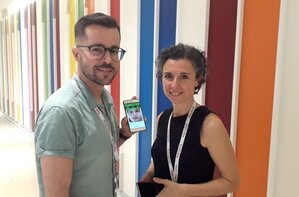Professionals at Sant Joan de Déu make it easier for doctors around the world to diagnose a rare disease
They analysed the most remarkable traits of children suffering from PMM2-CDG and designed an app that uses a photograph of the patient's face to suggest a diagnosis.
Face2Gene is a smartphone application that facilitates the difficult task of diagnosing minority and very rare diseases. Using a photograph of the patients, the application analyses their facial features and compares them with those recorded in the database. Thanks to artificial intelligence, it can then make a diagnostic proposal.
Two professionals at the Sant Joan de Déu Research Institute have helped to improve the functionality of this application for the diagnosis of PMM2-CDG disease (phosphomannomutase deficiency).
Given the lack of knowledge of the disease and its rarity, Mercedes Serrano, paediatric neurologist, and Antonio Martínez Monseny, clinical geneticist at the Sant Joan de Déu Barcelona Children's Hospital, have developed facial recognition tools for diagnosis by doctors around the world who are unfamiliar with this genetic condition.
The doctors only have to contrast a photo of their patients with the anonymous mask that the Face2Gene application has generated from the photos of 31 case studies in order to find out if the patient has the phenotype with the characteristic traits of PMM2-CDG and, if so, carry out other complementary tests to confirm the diagnosis.
A minority disease with a very characteristic facial pattern
The cause of PMM2-CDG is a congenital metabolic error and affects about 50 children in Spain. In 30% of cases it is especially serious and can lead to death.
Patients display different degrees of cerebellar syndrome, which is manifested by symptoms similar to those of alcohol intoxication: they walk unsteadily, speak with a slur, tremble and cannot control the movement of their hands or eyes, and their thinking is slower.
PMM2-CDG is associated with a recognisable facial pattern, which has made it possible to record the appearance of patients to train facial recognition tools and include this information in the Face2Gene smartphone application.
Dr Serrano and Dr Martínez have led the study to identify these physical traits characteristic of PMM2-CDG patients and identify the facial pattern that make its possible to ascertain the prognosis or evolution of the disease at an early stage. To do this, they counted on a sample of 31 cases from all over Spain, most of them paediatric patients affected by this disease, whose clinical histories were available thanks to the networking carried out by their doctors.
The study identified some typical traits of children with PMM2-CDG: upslanted palpebral fissure, strabismus, lipodystrophy, inverted nipples, long philtrum, large mouth, long fingers, and joint hyperlaxity.
In addition, they came to the conclusion that patients who already display lipodystrophy and inverted nipples during the first months of life will suffer from the disease more severely.
Information about the prognosis of the disease is not currently provided by genetic diagnosis because there is no relationship between the type of mutations and the seriousness of the condition.
This study was published recently in the Journal of Medical Genetics (IF 5,751).

Face2Gene is a smartphone application that facilitates the difficult task of diagnosing minority and very rare diseases.
